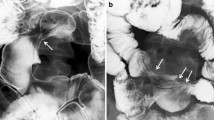Abstract
Chronic nonspecific multiple ulcer of the small intestine (CNSU) is an enteropathy characterized by persistent anemia and hypoproteinemia occurring in childhood or adolescence [1]. CNSU was advocated as an established disease entity in the 1960s. At one time, it was called “nonspecific ulcers in the small intestine,” but this ragtag disease name was not suitable for an established disease entity.
The work was first published in 2006 by Springer Medizin Verlag Heidelberg with the following title: Atlas of Video Capsule Endoscopy.
Access provided by Autonomous University of Puebla. Download chapter PDF
Similar content being viewed by others
Keywords
- Chronic nonspecific multiple ulcer of the small intestine
- CNSU
- Nonspecific ulcers in the small intestine
- Anemia
- Hypoproteinemia
- Sharply marginated ulcer
- Circular ulcer
- Oblique ulcer
- Stricture
- Endoscopic balloon dilation
- Nutrition therapy
Chronic nonspecific multiple ulcer of the small intestine (CNSU) is an enteropathy characterized by persistent anemia and hypoproteinemia occurring in childhood or adolescence [1]. CNSU was advocated as an established disease entity in the 1960s. At one time, it was called “nonspecific ulcers in the small intestine,” but this ragtag disease name was not suitable for an established disease entity.
32.1 Etiology
The etiology and pathogenesis of CNSU have not yet been clarified. Intermarriage has been reported in the family background of some patients, so a genetic factor may be involved.
32.2 Clinical Features
The lesions of CNSU are most common in the middle or lower ileum [2]; in some patients they appear in the jejunum or colon. Typical macroscopic findings are multiple, sharply marginated, circular, or oblique ulcers in the middle or lower ileum, except the terminal ileum [3] (Fig. 32.1). The ulcer is shallow, and the wall thickening of the small intestine is mild. Therefore, even though some strictures can be formed, endoscopic balloon dilation therapy is usually easier and safer than in Crohn’s disease [4]. Recurrence after surgical resection often occurs.
CNSU occurs more often in women than in men [5]. Persistent anemia and hypoproteinemia result in easy fatigability, edema, growth impairment, or amenorrhea. Abdominal obstructive symptoms can occur because of stricture, but diarrhea or bloody stool is rare.
In spite of severe anemia or hypoproteinemia, the level of C-reactive protein (CRP) is normal or only mildly elevated. Fecal occult blood test is positive.
32.3 Histology
The ulcers are localized in the mucosal or submucosal layer (Fig. 32.2). Typical microscopic findings are mild inflammatory cell infiltrate with plasma cells, lymphocytes, and eosinophils.
32.4 Differential Diagnosis
The differential diagnosis of CNSU includes Crohn’s disease, intestinal tuberculosis, radiation enteropathy, and nonsteroidal anti-inflammatory drug (NSAID) enteropathy. The typical findings for ulcer description, location, history, response to treatment, and supportive laboratory data are useful in making the diagnosis.
32.5 Treatment
Anti-inflammatory treatments including steroids, 5-aminosalicylate, immunomodulators, and anti-TNFα agents have not been effective. At present, the only effective method to induce and maintain remission of CNSU is nutrition therapy with total parenteral nutrition or elemental diet.
32.6 Endoscopy
Circular or oblique, sharply marginated, shallow ulcers are observed mainly in the ileum [6] (Figs. 32.3 and 32.4). Scars, strictures, and pseudodiverticulosis also can be observed (Figs. 32.5 and 32.6). Double-balloon or single-balloon enteroscopy is useful for observation.
32.6.1 The Role of Capsule Endoscopy
Capsule endoscopy is useful for differential diagnosis or confirming treatment efficacy in some cases (Figs. 32.7 and 32.8). Confirming functional patency of the small intestine by using patency capsule is usually required prior to capsule endoscopy (Figs. 32.9 and 32.10) [7].
References
Matsumoto T, Kubokura N, Matsui T, et al. Chronic nonspecific multiple ulcer of the small intestine segregates in offspring from consanguinity. J Crohns Colitis. 2011;5:559–65.
Matsumoto T, Iida M, Matsui T, et al. Non-specific multiple ulcers of the small intestine unrelated to non-steroidal anti-inflammatory drugs. J Clin Pathol. 2004;57:1145–50.
Matsumoto T, Nakamura S, Esaki M, et al. Endoscopic features of chronic nonspecific multiple ulcers of the small intestine: comparison with nonsteroidal anti-inflammatory drug-induced enteropathy. Dig Dis Sci. 2006;51:1357–63.
Ohmiya N, Arakawa D, Nakamura M, et al. Small-bowel obstruction. Diagnostic comparison between double-balloon endoscopy and fluoroscopic enteroclysis, and the outcome of enteroscopic treatment. Gastrointest Endosc. 2009;69:84–93.
Chen Y, Ma WQ, Chen JM, et al. Multiple chronic non-specific ulcer of small intestine characterized by anemia and hypoalbuminemia. World J Gastroenterol. 2010;16:782–4.
Matsumoto T, Iida M, Matsui T, Yao T. Chronic nonspecific multiple ulcers of the small intestine: a proposal of the entity from Japanese gastroenterologists to Western enteroscopists. Gastrointest Endosc. 2007;66 Suppl 3:S99–107.
Tokuhara D, Watanabe K, Okano Y, et al. Wireless capsule endoscopy in pediatric patients: the first series from Japan. J Gastroenterol. 2010;45:683–91.
Author information
Authors and Affiliations
Corresponding author
Editor information
Editors and Affiliations
Rights and permissions
Copyright information
© 2014 Springer-Verlag Berlin Heidelberg
About this chapter
Cite this chapter
Watanabe, K. (2014). Chronic Nonspecific Multiple Ulcer of the Small Intestine. In: Keuchel, M., Hagenmüller, F., Tajiri, H. (eds) Video Capsule Endoscopy. Springer, Berlin, Heidelberg. https://doi.org/10.1007/978-3-662-44062-9_32
Download citation
DOI: https://doi.org/10.1007/978-3-662-44062-9_32
Published:
Publisher Name: Springer, Berlin, Heidelberg
Print ISBN: 978-3-662-44061-2
Online ISBN: 978-3-662-44062-9
eBook Packages: MedicineMedicine (R0)














